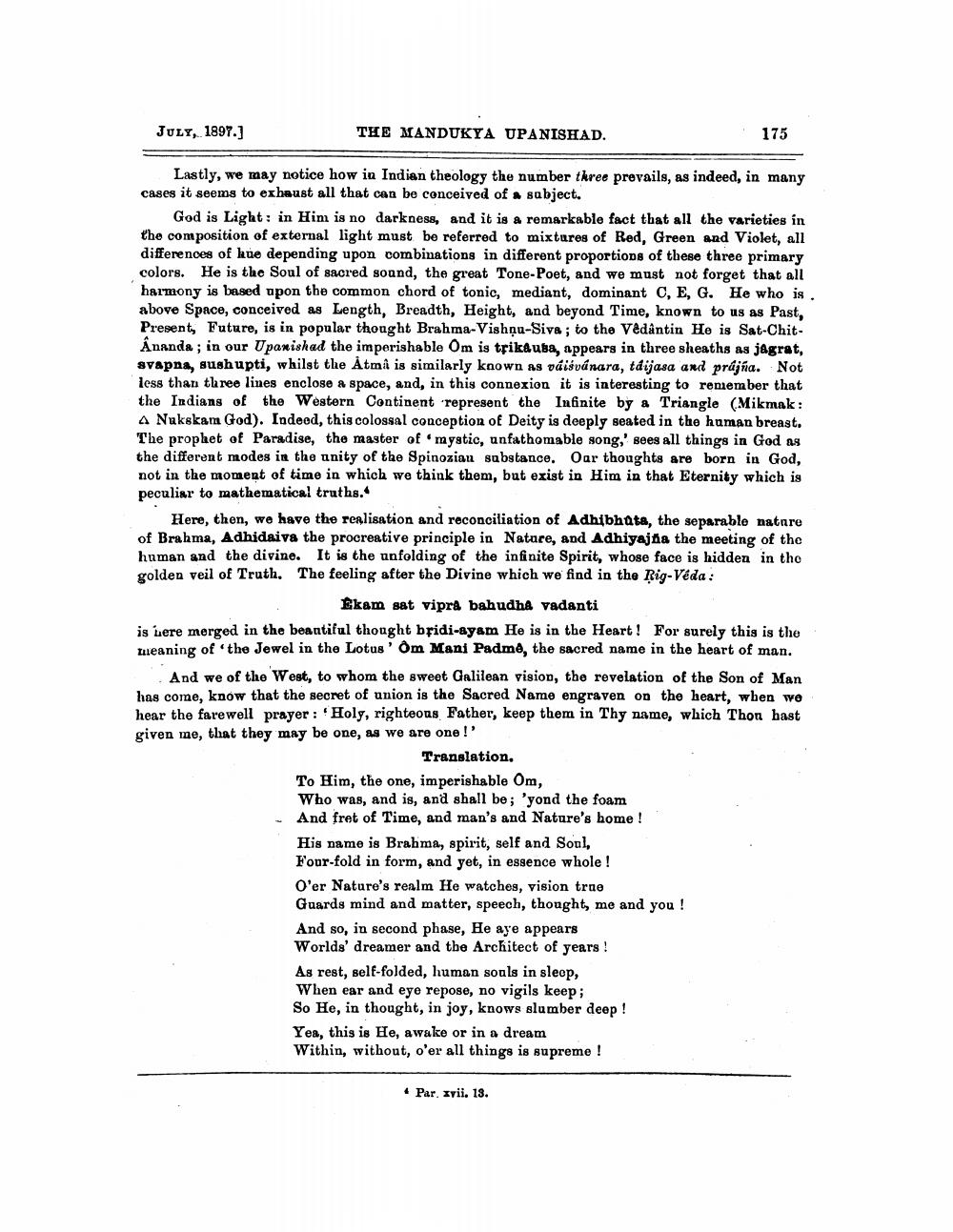________________
JULY, 1897.]
THE MANDUKYA UPANISHAD.
175
Lastly, we may notice how in Indian theology the number three prevails, as indeed, in many cases it seems to exhaust all that can be conceived of subject.
God is Light : in Him is no darkness, and it is a remarkable fact that all the varieties in the composition of external light must be referred to mixtures of Red, Green and Violet, all differences of kue depending upon combinations in different proportions of these three primary colors. He is the Soul of sacred sound, the great Tone-Poet, and we must not forget that all harmony is based upon the common chord of tonic, mediant, dominant C, E, G. He who is. above Space, conceived as Length, Breadth, Height, and beyond Time, known to us as Past, Present, Future, is in popular thought Brahma-Vishņu-Sive; to the Vedantin Ho is Sat-ChitÂnanda; in our Upanishad the imperishable Om is trikdusa, appears in three sheaths as jagrat, svapna, sushupti, whilst the Atma is similarly known as váisvánara, taijasa and prajfia. Not less than three lines enclose a space, and, in this connexion it is interesting to remember that the Indians of the Western Continent represent the Infinite by a Triangle (Mikmak: A Nakskam God). Indeed, this colossal conception of Deity is deeply seated in the human breast, The prophet of Paradise, the master of mystic, unfathomable song,' sees all things in God as the different modes in the unity of the Spinoziau substance. Oar thoughts are born in God, not in the moment of time in which we think them, but exist in Him in that Eternity which is peculiar to mathematical truths.
Here, then, we have the realisation and reconciliation of Adhibhuta, the separable natnre of Brahma, Adhidaiva the procreative principle in Nature, and Adhiyajta the meeting of the human and the divine. It is the unfolding of the infinite Spirit, whose face is hidden in the golden veil of Truth. The feeling after the Divine which we find in the Rig Véda :
Ekam sat vipra bahudha vadanti is were merged in the beautiful thought bfidi-ayam He is in the Heart! For surely this is the tuleaning of the Jewel in the Lotus ' Om Mani Padme, the sacred name in the heart of man.
And we of the West, to whom the sweet Galilean vision, the revelation of the Son of Man has come, know that the secret of union is the Sacred Name engraven on the heart, when we hear the farewell prayer: Holy, righteons Father, keep them in Thy name, which Thon hast given me, that they may be one, as we are one!'
Translation. To Him, the one, imperishable Om, Who was, and is, and shall be; 'yond the foam And fret of Time, and man's and Nature's home! His name is Brahma, spirit, self and Soul, Four-fold in form, and yet, in essence whole ! O'er Nature's realm He watches, vision true Guards mind and matter, speech, thought, me and you ! And so, in second phase, He aye appears Worlds' dreamer and the Architect of years! As rest, self-folded, human souls in sleep, When ear and eye repose, no vigils keep; So He, in thought, in joy, knows slumber deep! Yea, this is He, awake or in a dream Within, without, o'er all things is supreme !
• Par. xvii. 13.




